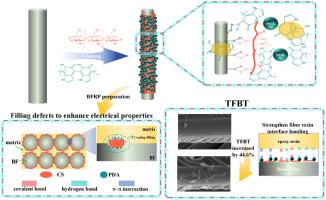用于跨尺度界面功能化的生物活性壳聚糖-聚多巴胺纳米颗粒:增强玄武岩纤维复合材料的电绝缘和机械性能
IF 7.7
2区 材料科学
Q1 MATERIALS SCIENCE, COMPOSITES
引用次数: 0
摘要
玄武岩纤维与基体的界面粘结性差,限制了其在电气设备领域的应用,而大多数界面处理都面临着技术复杂性和环境污染的问题。本研究将壳聚糖(CS)和聚多巴胺(PDA)纳米粒子协同构建在玄武岩纤维表面,形成一种跨尺度的生物活性复合涂层,通过表征玄武岩纤维的润湿性,分析了界面结合增强的机理,并对复合材料进行了电学和力学性能测试。结果表明,与CR-BF相比,DCS-BF-2的抗拉强度提高了53.66%,树脂渗透性提高了63.38%,渗透性能更加突出。与未经处理的CR-BFRP相比,DCS-BFRP-2复合材料的绝缘性能和力学性能得到了改善,击穿强度和闪络电压分别提高了16.01%和31.93%,介质损耗降低了33.71%。力学性能方面,DCS-BFRP-2纤维束的横向抗拉强度提高了39.62%,复合材料的抗弯强度和层间剪切强度分别提高了19.50%和43.9%,纤维-树脂界面结合性能也得到了有效改善。本文章由计算机程序翻译,如有差异,请以英文原文为准。

Bioactive chitosan-polydopamine nanoparticles for cross-scale interfacial functionalization: Enhanced electrical insulation and mechanical properties of basalt fiber composites
The poor interfacial bonding between basalt fibers and the matrix restricts its application in the field of electrical equipment, while most interfacial treatments face the problems of technical complexity and environmental pollution. In this study, chitosan(CS) and polydopamine (PDA) nanoparticle were synergistically constructed on the surface of basalt fibers in order to form a cross-scale bioactive composite coating, the mechanism of interfacial bonding enhancement was analyzed by characterizing the wettability of basalt fibers, and electrical and mechanical property tests were carried out for the composites. The results showed that DCS-BF-2 exhibited a 53.66 % increase in tensile strength and 63.38 % increase in resin permeability compared to CR-BF, exhibiting more prominent infiltration properties. Compared to the untreated composite CR-BFRP, DCS-BFRP-2 composites showed improved insulating and mechanical properties: the breakdown strength and flashover voltage increased by 16.01 % and 31.93 %, respectively, and the dielectric loss decreased by 33.71 %. In terms of mechanical properties, the transverse tensile strength of DCS-BF-2 fiber bundles was increased by 39.62 %, the flexural strength and interlayer shear strength of DCS-BFRP-2 composites were increased by 19.50 % and 43.9 %, respectively, and the fiber-resin interfacial bonding performance was also effectively improved.
求助全文
通过发布文献求助,成功后即可免费获取论文全文。
去求助
来源期刊

Composites Communications
Materials Science-Ceramics and Composites
CiteScore
12.10
自引率
10.00%
发文量
340
审稿时长
36 days
期刊介绍:
Composites Communications (Compos. Commun.) is a peer-reviewed journal publishing short communications and letters on the latest advances in composites science and technology. With a rapid review and publication process, its goal is to disseminate new knowledge promptly within the composites community. The journal welcomes manuscripts presenting creative concepts and new findings in design, state-of-the-art approaches in processing, synthesis, characterization, and mechanics modeling. In addition to traditional fiber-/particulate-reinforced engineering composites, it encourages submissions on composites with exceptional physical, mechanical, and fracture properties, as well as those with unique functions and significant application potential. This includes biomimetic and bio-inspired composites for biomedical applications, functional nano-composites for thermal management and energy applications, and composites designed for extreme service environments.
 求助内容:
求助内容: 应助结果提醒方式:
应助结果提醒方式:


